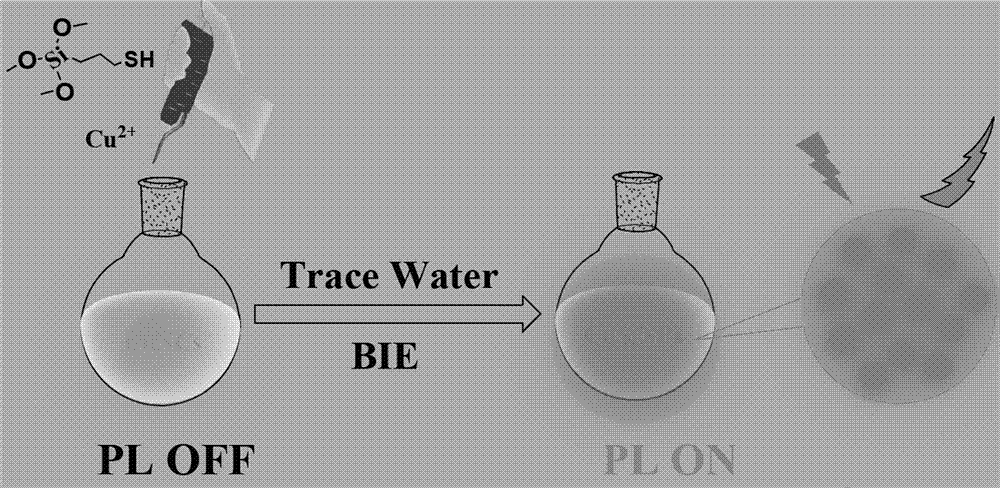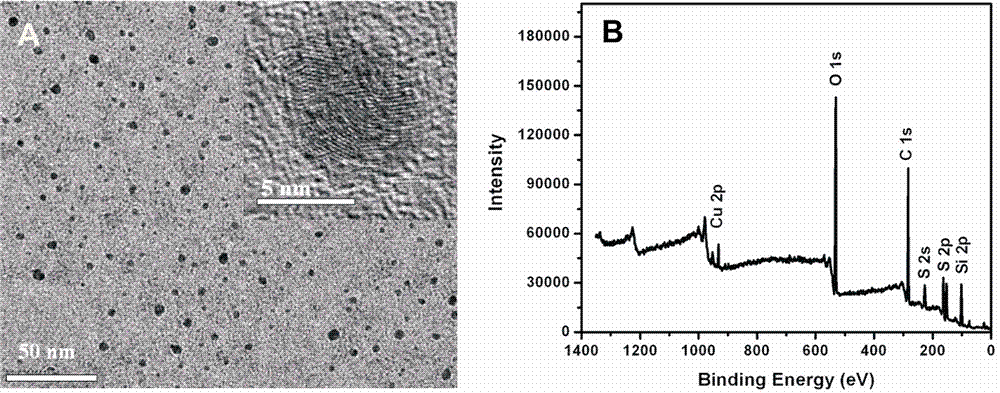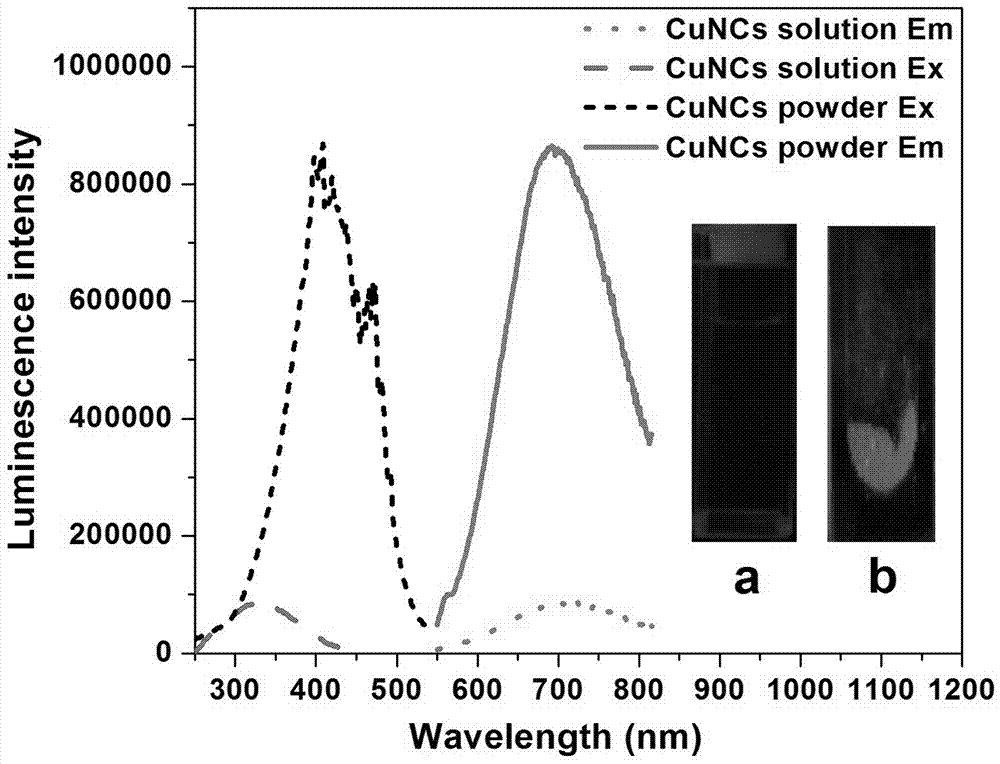Method for synthesizing copper nano-clusters modified by silane in one step and application of copper nano-clusters modified by silane in detecting trace water-content in organic solvent
A technology of copper nano-clusters and organic solvents, applied in the preparation and application of functional nano-ions, can solve problems such as interference, inapplicability to trace water detection, instability, etc., and achieve fast reaction speed, easy promotion, stability and light resistance good sex effect
- Summary
- Abstract
- Description
- Claims
- Application Information
AI Technical Summary
Problems solved by technology
Method used
Image
Examples
Embodiment 1
[0031] Embodiment 1: One-step method for synthesizing copper nanoclusters modified by mercaptopropyltrimethoxysilane
[0032] Such as figure 1 As indicated, weigh 6 mg of copper nitrate, place it in 20 mL of anhydrous acetonitrile, add 25 μL of mercaptopropyltrimethoxysilane, and stir for 20 to 40 minutes under airtight room temperature conditions to obtain mercaptopropyltrimethoxysilane-modified Cu nanoclusters with a calculated yield of 95%. Such as figure 2 The TEM imaging results in A show that the prepared mercaptopropyltrimethoxysilane-modified copper nanoclusters are approximately spherical in shape, uniform in size, good in dispersion, and free from agglomeration, and the particle size is mainly distributed in the range of 2-6 nm. Such as figure 2 The XPS pattern in B shows that the copper nanoclusters are mainly composed of five elements: carbon, oxygen, silicon, copper, and sulfur. Such as image 3 As shown, at the excitation wavelength of 340 nm, the fluores...
Embodiment 2
[0033] Embodiment 2: One-step method for synthesizing copper nanoclusters modified by mercaptoethyltriethoxysilane
[0034] Such as figure 1 as shown in figure 1 As shown, weigh 6 mg of copper sulfate, place it in 20 mL of anhydrous acetonitrile, add 34.5 μL of mercaptoethyltriethoxysilane, and stir for 20 to 40 minutes under airtight room temperature conditions to obtain mercaptoethyltriethoxysilane Silane-modified copper nanoclusters with a calculated yield of 90%. Characterized by TEM, XPS and fluorescence spectra, the copper nanoclusters modified by mercaptoethyltriethoxysilane and the copper nanoclusters modified by mercaptopropyltrimethoxysilane are similar in shape, size, elemental composition and fluorescence emission. They are all approximately spherical in shape, with a size between 2 and 6 nm. The elements are mainly composed of five elements: carbon, oxygen, silicon, copper and sulfur. They emit faint red light under ultraviolet light, and the fluorescence spectr...
Embodiment 3
[0035] Example 3: One-step synthesis of copper nanoclusters modified by mercaptopropylmethyldiethoxysilane
[0036] Such as figure 1 As shown, weigh 60 mg of copper chloride, place it in 100 mL of anhydrous acetonitrile, add 422 μL of mercaptopropylmethyldiethoxysilane, and stir for 20 to 40 minutes under airtight room temperature conditions to obtain mercaptopropyl methyl Diethoxysilane-modified copper nanoclusters with a calculated yield of 90%. Characterized by TEM, XPS and fluorescence spectra, the copper nanoclusters modified with mercaptopropylmethyldiethoxysilane and the copper nanoclusters modified with mercaptopropyltrimethoxysilane have different properties such as morphology, elemental composition and fluorescence emission. Similar, they are all approximately spherical in shape, with a size between 2 and 6 nm. The elements are mainly composed of five elements: carbon, oxygen, silicon, copper, and sulfur. They emit faint red light under ultraviolet light, and their...
PUM
 Login to View More
Login to View More Abstract
Description
Claims
Application Information
 Login to View More
Login to View More - R&D
- Intellectual Property
- Life Sciences
- Materials
- Tech Scout
- Unparalleled Data Quality
- Higher Quality Content
- 60% Fewer Hallucinations
Browse by: Latest US Patents, China's latest patents, Technical Efficacy Thesaurus, Application Domain, Technology Topic, Popular Technical Reports.
© 2025 PatSnap. All rights reserved.Legal|Privacy policy|Modern Slavery Act Transparency Statement|Sitemap|About US| Contact US: help@patsnap.com



